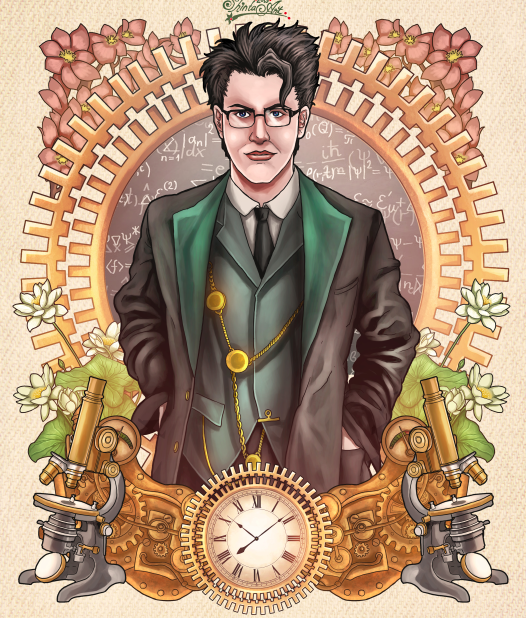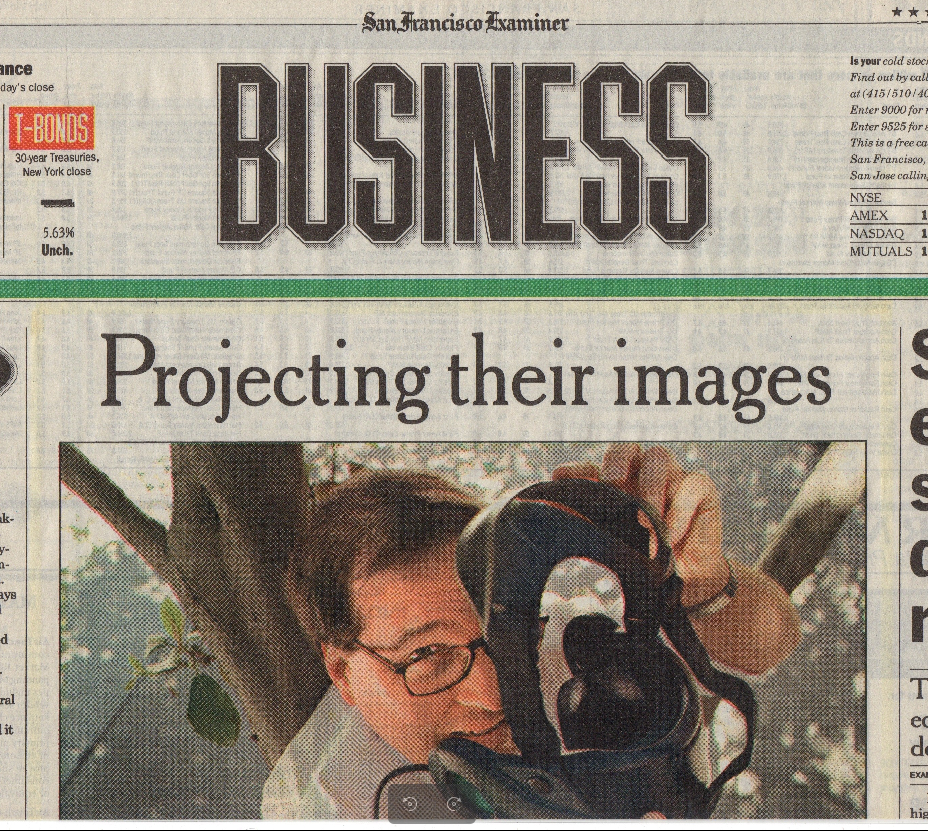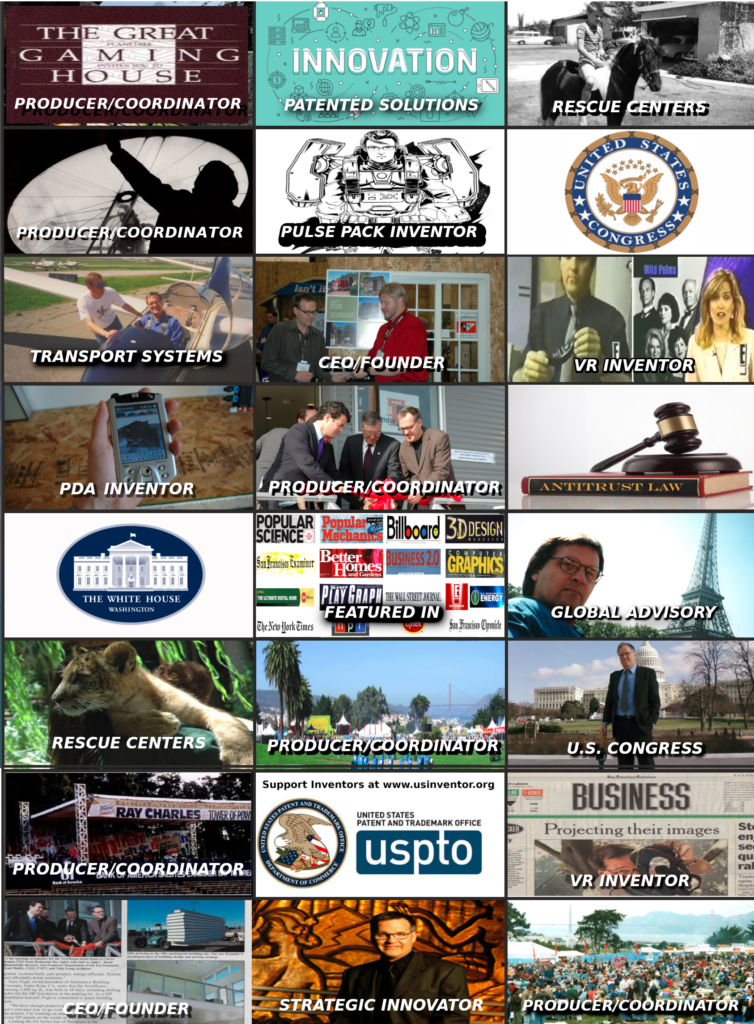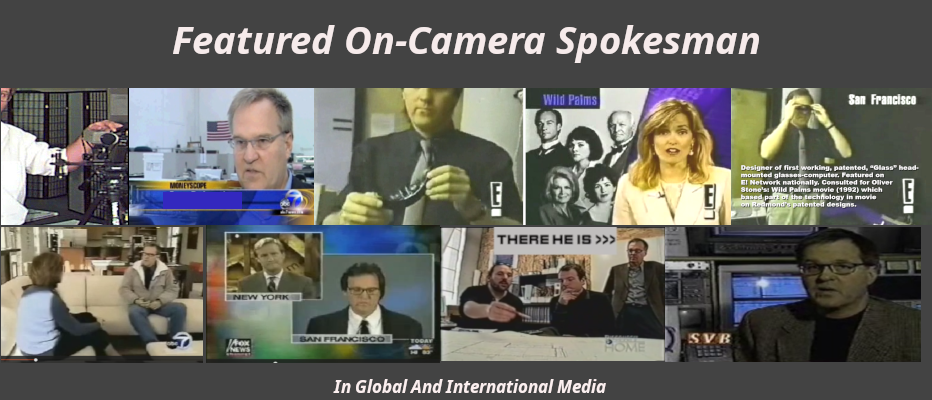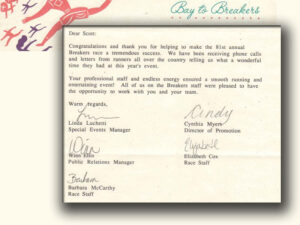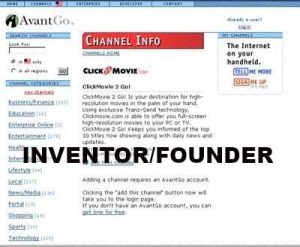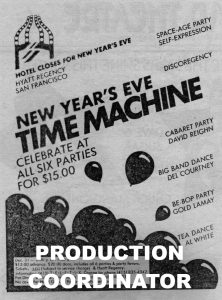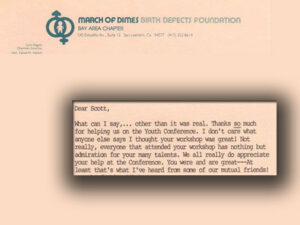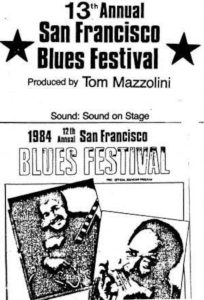THE AUGMENTED REALITY EXPERIENCES (ARGS)
My Great Gaming House project and other ARG’s were always great fun.
See Also:
and other contemporaneous social immersion projects…
Of course, this article is still a great point-of-departure:
ARG, ARG, VR, AR, MR, XR . . . There are enough acronyms out there to make your head spin. But this alphabet soup contains legitimate learning and development (L&D) tools. Let’s examine each term and describe how these tools can be used in the modern training, intelligence and marketing environments. Yes, even the CIA and KGB/FSB use these social technologies.
ARG and ARG
ARG is cast around from time to time as a method of conducting training programs, but there is a lot of confusion related to the letters because there are two similar but differing meanings. In the first definition, the “A” represents alternative. In the second definition, the “A” represents augmented. Let’s look at each definition.
Alternative Reality Game
In The Gamification of Learning and Instruction, contributing author Koreen Olbrish states that “Alternate reality games (ARGs), also sometimes called pervasive games or transmedia storytelling, are designed to combine real life and digital game play elements. So . . . you are playing the game in the real world but doing behaviors that are linked to the game.”
In the 2016 book Alternate Reality Games: Gamification for Performance, Andy Petroski and Charles Palmer describe an ARG as being built around a story that engages the players through an anomaly in their regular schedule. It could be an email from an unknown source. It could be a note on a desk or a message on a computer screen like “Follow the white rabbit.” The realism of the story is strong at the beginning of the ARG. Most ARGs include a combination of real-world activities in a physical location and digital media.
Typically, ARGs are “tracked” online, but the actual game play consists of real-life activities. There are many entertainment-based ARG examples, including Microsoft’s I Love Bees (perhaps the most famous), ABC’s Lost—The Lost Experience, and CBS’s Numb3rs—Chain Factor. Examples of ARGs for social issues include Urgent Evoke and World Without Oil. The popularity of ARGs for entertainment and game and television tie-ins seemed to peak around late 2006; however, some ARGs are available and the genre has not completely disappeared. For example, the musical group Twenty One Pilots used an ARG called DEMA. The story/game was about a man escaping from an oppressive organization called DEMA.
Click this link to watch an explanation of I Love Bees, a great case study of an ARG.
Petroski argues that ARGs can be used for a variety of training purposes. The article “Alternate Reality Game Benefits for Your Organization” specifies four case studies where ARGs were used for immersion into new programs, helping teach collaboration and teamwork, optimizing training time by making pre-work more engaging and interesting, and helping learners to hone skills through an interactive story. He says, “Learning doesn’t happen at a moment in time and that knowledge, skills, and attitudes are built over extended periods of exploration, practice, feedback, and reflection. ARGs provide that extended learning time because they can integrate into work and life activities throughout the day and can take place over an extended period.” While this definition of ARG has a lot of potential in the L&D world, it is not as popular as the other definition of the acronym ARG.
Augmented Reality Game
An augmented reality game occurs when a game superimposes images, sound, or items onto the real world. Perhaps the best-known ARG of this kind of all time is Pokémon Go. (Image shows a Pokémon in front of Karl Kapp’s house in an ARG.)

Augmented reality means that reality is enhanced, made better, or provides more information because some type of computer device is adding information. Items are added onto reality via a mitigating technology. A person must be looking through a device to see the augmented reality. You have to hold up your phone, put on the glasses, or look through some type of screen to see the augmentation. (Below is an image from the ARG Harry Potter: Wizards Unite.)

Here is a great video from BMW that shows the potential of augmented reality in the realm of training. This video shows how AR can be used in a practical training situation and as performance support to help an employee complete tasks.
Augmented reality is already used in factories to help shop floor workers pick the right materials, properly assemble parts, and to quickly access refresher information when needed. This article explains how Google Glass’s augmented reality elements are helping improve employee performance.
Meet OXR (Organic Expanded Reality) – The Headset-Free Options
So now that we know what AR represents, how does virtual reality (VR) fit into this explanation? The big difference between the two is that with virtual reality, you are completely immersed in a virtual space and don’t see anything real.
When a learner “goes into” virtual reality, they put on a headset and are no longer in touch with reality. The only thing the learner can see is what is displayed on the screen in front of them. VR is a purely virtual experience without any intent to integrate with the real world. AR immerses the user completely in an audio and video reality all its own.
The headsets are bulky and many people are experimenting with headset-free options. The military has a system that can project sounds and images directly into the brain but the long-term dangers of direct electronic tissue sampling and remote tissue input are not yet known. Many people believe that the Havana Syndrome attacks ( https://en.wikipedia.org/wiki/Havana_syndrome ) are satellite or distant vehicle based abuses of the technology.
Advanced consumer experimenters tend to use the following process described in these quotes from this paper:
“… at 9PM each night, networked OXR experiments begin around the globe. Users take a doctor-prescribed “Sublime” pill. They usually melt it under their tongue. They then open a full screen link (ie: http://live-large.org/wp-content/uploads/LIGHT1/ ) or ( https://www.reddit.com/r/software/comments/67zqg4/programs_for_making_psychedelic_visuals/ ) and their experience begins within a half hour, or less.
Experienced, or highly evolved, users do not need the pill. They can move into these ‘metaverses’, on their own, without the need for optimization drugs. It takes practice for them to craft the experiences without the Sublime pill but many have become expert at it.
This is very different than the Timothy Leary LSD experiments with the original Swiss Labs LSD compound by Swiss chemist Albert Hofmann ( The only ‘real’ LSD that has ever existed – all others are just bare commercialized shades of that first formula).
Sublime and self-actuated OXR does not get you ‘high’, it amps up your entire natural brain functions…
…some users claim to be able to move between the actual physics metaverse segments as described in the “Tegmark alternate realities”, (after Max Tegmark at MIT ( http://space.mit.edu/home/tegmark), who did calculations on it, proving that, per scientific facts, it exists. He says that if the Universe truly is infinite in space, it means that every configuration of elementary particles that is physically possible must occur somewhere. Ask any big name physics smarty-pants super-brain person.
This includes a world that is exactly like this one, but where two grains of sand in Morocco have exchanged places. Identical copies of you and me also exist in that world, of course. There’s another with unicorns—not magical ones, of course, but horse-like creatures with a single horn on the forehead; there’s no physical reason why they couldn’t exist. And another where, through a chain of unlikely events, you were only this morning proclaimed Emperor of China.
… And not only that, but there has to be an infinite number of identical copies of us (and also of the Chinese Emperor you). That’s how big infinity is: it is big enough to contain an infinite number of anything.
There’s even an infinite number of Hilberts ( see ‘ Hilbert’s paradox of the Grand Hotel’ (https://simple.wikipedia.org/wiki/Hilbert%27s_paradox_of_the_Grand_Hotel ) out there, all hard at work at building hotels with an infinite number of rooms.
The proof, either way, can be simply determined by closing your eyes, very tightly, in a dark room and uttering a focus chant word and using your own static quantum electricity from the 80 billion neurons in your head. ( Your brain has more static energy ( https://jonlieffmd.com/blog/brain-electricity-and-the-mind ) than a thunderstorm ) Upon opening your eyes you will be in a different metaverse but you will not be aware that you are. You can do this an infinite number of times. Each time you shift, you will ONLY have the memory of the metaverse you moved to and you will be able to create any future, that you can imagine, from that point forward. You will have no memory of the last metaverse you occupied. Sublime has a Versed-like amnesia effect, in many.
Try it! You are only limited by your Imagination…”
The horrifying ‘K-Hole’ bad trip effect of Ketamine can kick your mind into what appears to be the center of the universe, where you are endlessly falling through the largest and most lonely space in eternity. Many who experience the terrible ‘K-Hole’ never want to experience it again. Ketamine is NOT Sublime and should never be used for entertainment options. It does, though, give you a worse-case scenario of the bad side of OXR. If you played the video game: “DOOM ETERNAL” in OXR, it would probably be a lot like a K-Hole. Do not try it!
Headset or OXR VR can be used for teaching all type of activities—for example, teaching how to run meetings, assemble items, empathize with others, or conduct a sales call. VR tends to have more of a training or learning focus than AR because in VR the learner can practice skills in a realistic setting. The image below shows a VR environment where a salesperson can practice sales skills in a realistic setting using the LearnBrite tool and the ZSA game.

On the other hand, with AR you can walk step-by-step through performing the skills, as shown in the BMW example.
XR and MR
It is possible to be in a VR situation, fully immersed and wearing the headset, when, all of a sudden, through its built-in cameras the goggles show you reality. This mixed reality—a blending of virtual reality with the physical world—is almost the reverse of augmented reality. Instead of computer-generated images being superimposed on reality, reality is superimposed on top of digital images on the screens of your headset.
Labeling these categories of reality is cumbersome and constantly changes, so here is where our final term, extended reality (XR), comes into play. XR was created to be simply an all-encompassing term used by developers address all experiences, regardless of the reality.
Yes, you should care about the alphabet soup of “reality” terminology. They each have the potential to be powerful instructional tools that can provide a true performance support system. The BMW example clearly shows how to mix training with on-the-job actions. And the VR example from Interactive Sales Experience shows how VR can help train sales professionals.
Technology is driving a number of interesting advances in learning environments, but the fundamentals have not changed. The important thing for learning and development professionals to realize is that how people learn and what it means to motivate learners has not changed with technology. Now more than ever we need to know and put into practice evidence-based guidelines for developing instruction.
Ong’s Hat is one of the earliest Internet-based secret history conspiracy theories. It was created as a piece of collaborative fiction (a.k.a. Incunabula) by four core individuals, dating back to the 1980s, although the membership propagating the tale changed over time. Ong’s Hat is often cited as the first ARG on many lists of alternate reality games.
The characters were largely based in the ghost town of Ong’s Hat, New Jersey, hence the name of the project.
The threads of the story can be traced back as far as the 1980s on bulletin board systems, old xerox mail art networks and early zines. The aim was to create a fictional story line, and embed it in various media cultures to establish backstory. It may have started as an in-joke, or the first alternate reality game (ARG), a work of transmedia storytelling or as a memetic experiment, to see how far the meme could spread or a combination of all of the above.[1] The story eventually used print, radio, television and digital mediums (CD-ROM, DVD, Internet, BBS) in its dissemination.
The initial ground rules acknowledged the possibility that such an experiment could end up going down darker paths, and they specifically ruled out Ong’s Hat being used for cult-like activity. Even though it is a fiction, the tale may be based on earlier works.[2]
Joseph Matheny eventually concluded the project.[1][3] GamesTM magazine wrote that “Ong’s Hat was more of an experiment in transmedia storytelling than what we would now consider to be an ARG but its DNA – the concept of telling a story across various platforms and new media – is evident in every alternate reality game that came after.”[4]
In 2002, Lego created an ARG for their line of toys for Canadian children’s TV series Galidor that featured some elements of the Ong’s Hat story.[5]
Plot
The Ong’s Hat narrative is told in the form of conspiracy theories surrounding a group of renegade Princeton professors who had conducted quantum physics and chaos theory experiments to discover a new theory for dimensional travel using a device called “the egg”, and were camped out in a parallel world.[3] Their story is introduced through two documents, Incunabula: A Catalog of Rare Books, Manuscripts & Curiosa, Conspiracy Theory, Frontier Science & Alternative Worlds and Ong’s Hat: Gateway to the Dimensions.[3]
The story is said to begin in 1978 when a man named Wali Ford bought over 200 acres of forested land and set up an ashram. This ashram was built for seekers of spirituality, politics, tantra, and psychopharmacology. The ashram was a place for Princeton physicists, among other accredited scientists, to perform experiments involving interdimensional travel. It was rumored that they were trying to train the human mind to manipulate quantum physics and reality itself.
A device called The Egg was developed in the late 1980s by these scientists and physicists. This device was created as a variation of a sensory deprivation chamber, and it was used to help them determine when a wave becomes a particle. However, during a test one day, something unexpected happened: it disappeared. A young man who was inside the Egg when it disappeared explained that in the seven minutes the Egg was gone, he had traveled to another alternate dimension of the Earth. This other Earth was exactly the same as our Earth, however, it did not contain human life.
Throughout the years, they continued their experiments. However, when military efforts threatened the research being done by these physicists and scientists, they had to move their site somewhere else. Piece by piece, they moved their ashram to the other Earth. They left behind only the house where the gateway between worlds is held. The only time the people who live in the ashram return is when they need to restock supplies.
See also
- Creepypasta
- Robert Anton Wilson – Wikipedia
- The Blair Witch Project
- Church of the SubGenius
- lonelygirl15
- Fakelore
- SCP Foundation
Notes
- Kinsella, Michael (2011). Legend-Tripping Online: Supernatural Folklore and the Search for Ong’s Hat. Jackson, MS: University Press of Mississippi. ISBN 978-1604739831.
- Aspray, William. “The Princeton Mathematics Community in the 1930s, Transcript Number 41 (PMC41)”. The Trustees of Princeton University, 1985
- “The Ong’s Hat Mystery Revealed: An Interview with Joseph Matheny”. New World Disorder. Archived from the original on 15 July 2006. Retrieved 23 February 2013.
- McMahon, Chris (May 2013). “The Rise of the ARG: games™ investigates alternate reality games and what the future has in store for the curious experiment” (PDF). GamesTM. 135: 88. Archived (PDF) from the original on 14 September 2013. Retrieved 19 June 2015.
- “The LEGO® game console from another reality” (PDF). Lego. Retrieved 10 November 2021.
Further reading
- Matheny, Joseph (1999). The Incunabula Papers: Ong’s Hat and Other Gateways to New Dimensions. California: iMMERSION. ISBN 0-9674890-1-6.
- Matheny, Joseph (2002). Ong’s Hat: The Beginning. Oregon: Wildcard Interactive. ISBN 978-1726734691.
- Szulborski, Dave (2005). This Is Not A Game: A Guide to Alternate Reality Gaming. California: Hukilau. ISBN 978-1411625952.
- Kinsella, Michael (2011). Legend-Tripping Online: Supernatural Folklore and the Search for Ong’s Hat. Mississippi: University Press of Mississippi. ISBN 978-1604739831.
- McMahon, Chris (May 2013). “The Rise of the ARG: games™ investigates alternate reality games and what the future has in store for the curious experiment” (PDF). GamesTM. 135: 88.
- Ong’s Hat: The Beginning, a range of materials to download including the original book as well as graphic novels and CDs.
- Slate- Decoder Ring: The Incunabula Papers Slate podcast feature about the origins of the Ong’s Hat Project
- The Surprising Online Life of Legends
- GAMES™ INVESTIGATES ALTERNATE REALITY GAMES AND WHAT THE FUTURE HAS IN STORE FOR THE CURIOUS EXPERIMENT
- An interview with John Tukey at Princeton University on 11 April 1984 Includes references to an earlier Ong’s Hat story
Even though Pokemon seems totally ubiquitous to us (especially us Millennials who grew up with it) it’s worth explaining for those who maybe have heard of the game but still don’t know the specific terms.
We are excited to announce that our XR ARG has broken all past participant records. There are now more people, in more global regions, involved in more development levels than any other ARG we have been involved in. The Apple, Pimax, Arpara and Deckard VR headsets are all late, as expected, due to the usual issues, but all Steam VR interfaces are ready for them once they arrive in volume at 5K resolution, and higher. There are no delays re: IRL settings, of course and some of the hotel-based scenes are turning out to be epic.
No matter what phase you are in, hang in there: envelopes, thumb-drives and whispers will eventually reach you. Remember, Phase one is a ten year cycle, one of the largest in ARG history.
Onward and upward…
One of Scott’s Projects was THE GREAT GAMING HOUSE:
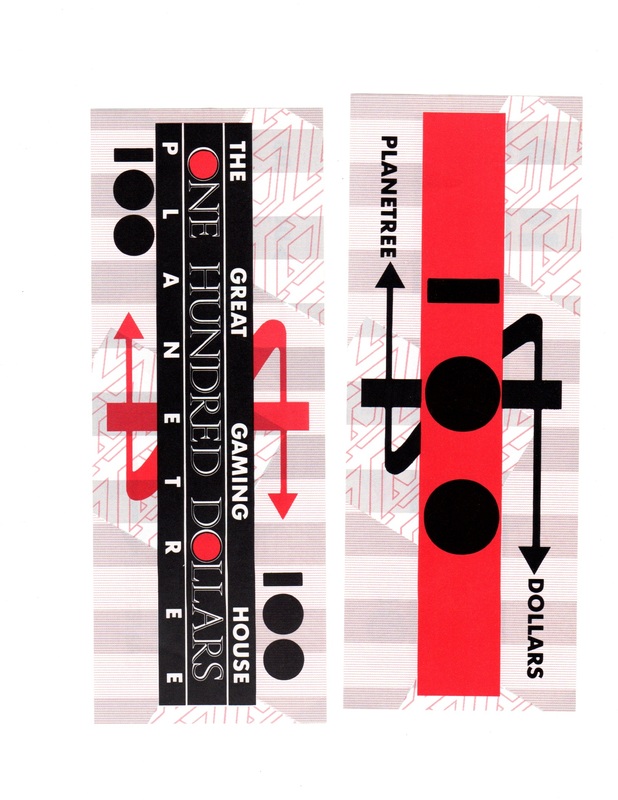
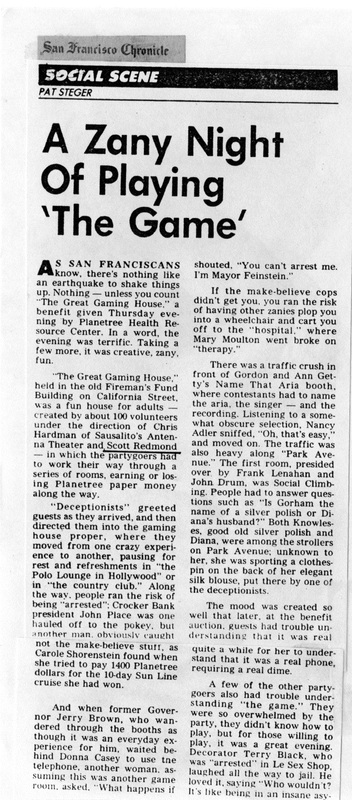
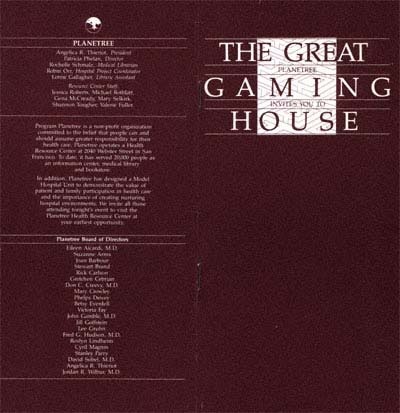
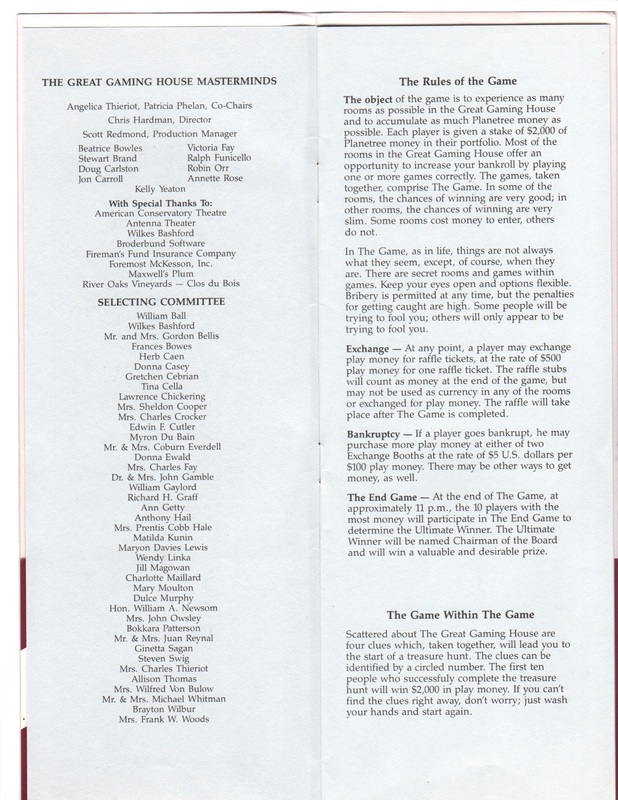
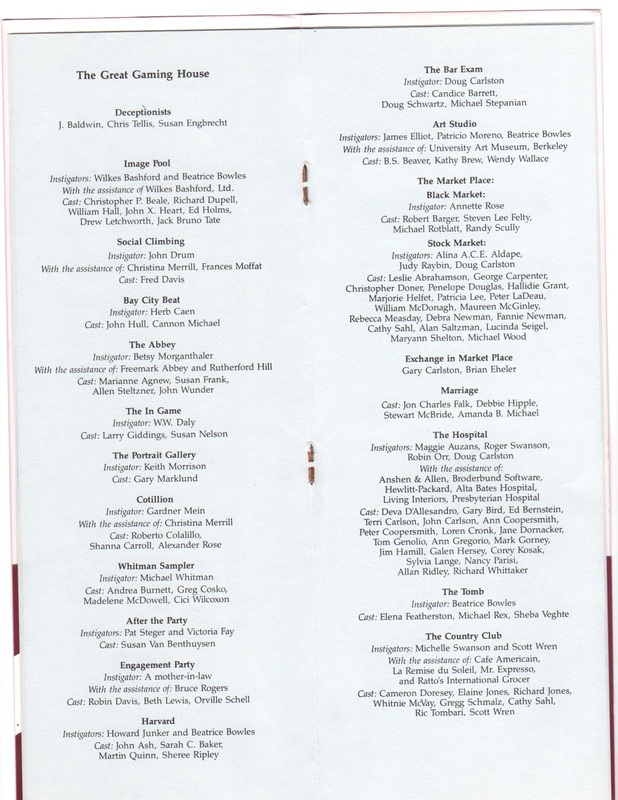
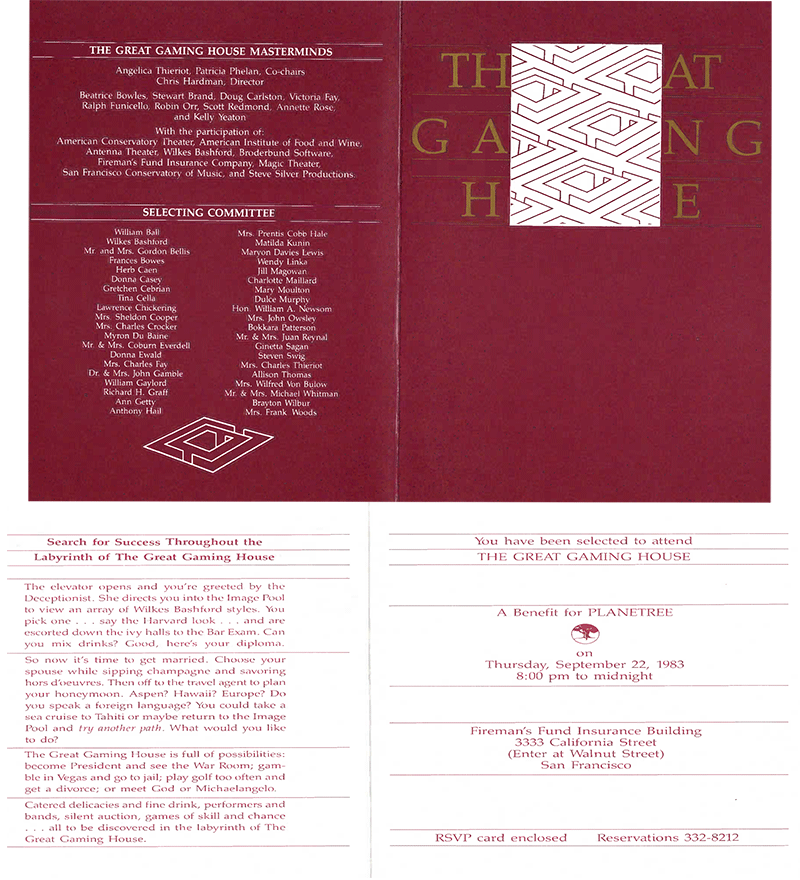
Also see: http://cardhouse.com/where
I lived across the street deom Dolores Park and got involved in that project via a side door.
